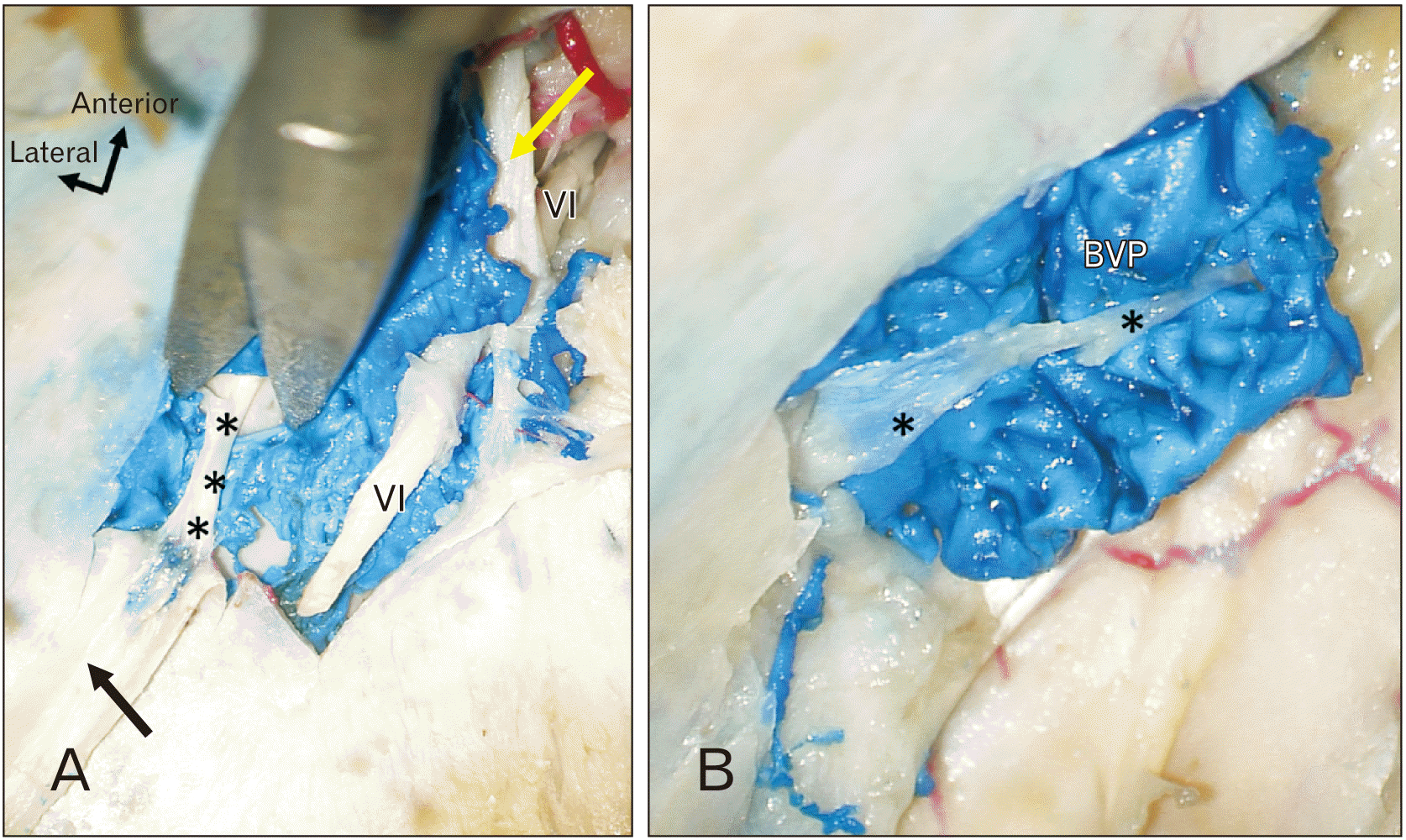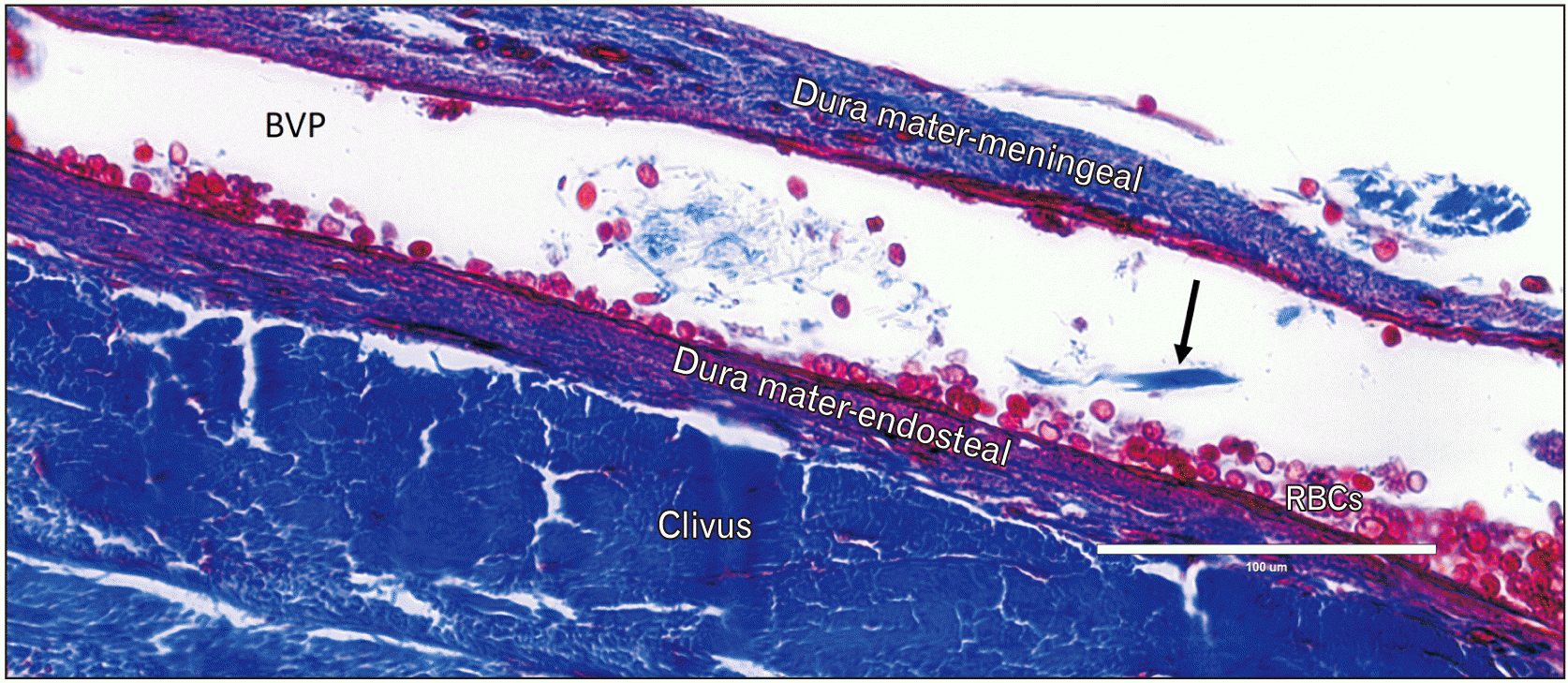1. Standring S. 2020. Gray's anatomy: the anatomical basis of clinical practice. 42nd ed. Elsevier;DOI:
10.5860/choice.43-1300.
2. Tubbs RS, Hansasuta A, Loukas M, Louis RG Jr, Shoja MM, Salter EG, Oakes WJ. 2007; The basilar venous plexus. Clin Anat. 20:755–9. DOI:
10.1002/ca.20494. PMID:
17415743.

3. Patel C, Tubbs RS. Tubbs RS, editor. 2020. The basilar plexus. Anatomy, Imaging and Surgery of the Intracranial Dural Venous Sinuses. Elsevier;p. 125–30. DOI:
10.1016/B978-0-323-65377-0.00013-1.
4. Arnautović KI, al-Mefty O, Pait TG, Krisht AF, Husain MM. 1997; The suboccipital cavernous sinus. J Neurosurg. 86:252–62. DOI:
10.3171/jns.1997.86.2.0252. PMID:
9010427.

5. Cunningham DJ, Robinson A. 1927. Cunningham's manual of practical anatomy. 8th ed. Oxford University Press;DOI:
10.5962/bhl.title.43984.
6. San Millán Ruíz D, Gailloud P, Rüfenacht DA, Delavelle J, Henry F, Fasel JH. 2002; The craniocervical venous system in relation to cerebral venous drainage. AJNR Am J Neuroradiol. 23:1500–8. PMID:
12372739. PMCID:
PMC7976803.
7. Mizutani K, Toda M, Kurasawa J, Akiyama T, Fujiwara H, Jinzaki M, Yoshida K. 2017; Analysis of the venous channel within the clivus using multidetector computed tomography digital subtraction venography. Neuroradiology. 59:213–9. DOI:
10.1007/s00234-017-1784-4. PMID:
28236049.

9. Wackenheim A, Braun JP. 1978. The veins of the posterior fossa: normal and pathologic findings. Springer-Verlag;DOI:
10.1007/978-3-642-66712-1.
12. Rai R, Iwanaga J, Shokouhi G, Loukas M, Mortazavi MM, Oskouian RJ, Tubbs RS. 2018; A comprehensive review of the clivus: anatomy, embryology, variants, pathology, and surgical approaches. Childs Nerv Syst. 34:1451–8. DOI:
10.1007/s00381-018-3875-x. PMID:
29955940.

13. Noblett D, Chang J, Shahlaie K. 2018; Prominent retroclival venous plexus, normal anatomic variant. Appl Radiol. 47:42–4. DOI:
10.37549/AR2500. PMID:
18947370.

14. Iwanaga J, Singh V, Ohtsuka A, Hwang Y, Kim HJ, Moryś J, Ravi KS, Ribatti D, Trainor PA, Sañudo JR, Apaydin N, Şengül G, Albertine KH, Walocha JA, Loukas M, Duparc F, Paulsen F, Del Sol M, Adds P, Hegazy A, Tubbs RS. 2021; Acknowledging the use of human cadaveric tissues in research papers: recommendations from anatomical journal editors. Clin Anat. 34:2–4. DOI:
10.1002/ca.23671. PMID:
32808702.

17. Coskun O, Hamon M, Catroux G, Gosme L, Courthéoux P, Théron J. 2000; Carotid-cavernous fistulas: diagnosis with spiral CT angiography. AJNR Am J Neuroradiol. 21:712–6. PMID:
10782783. PMCID:
PMC7976654.
18. Halbach VV, Higashida RT, Hieshima GB, Hardin CW, Pribram H. 1989; Transvenous embolization of dural fistulas involving the cavernous sinus. AJNR Am J Neuroradiol. 10:377–83. PMID:
2494857. PMCID:
PMC8331364.
19. Takahashi S, Kato K, Tomura N, Watarai J, Mizoi K. 2001; Dural arteriovenous fistula of the cavernous sinus with cortical venous reflux of the posterior fossa via a bridging vein. Radiat Med. 19:219–22.
20. Choi HY, Kim SB, Park S. 2015; Recurrent abducens nerve palsy due to basilar venous plexus engorgement. Neurol Sci. 36:1913–5. DOI:
10.1007/s10072-015-2271-5. PMID:
26041045.

21. Mizutani K, Akiyama T, Yoshida K, Toda M. 2018; Skull base venous anatomy associated with endoscopic skull base neurosurgery: a literature review. World Neurosurg. 120:405–14. DOI:
10.1016/j.wneu.2018.09.067. PMID:
30248466.

22. Wahl L, Lockwood JD, Keet K, Henry BM, Gielecki J, Iwanaga J, Bui CJ, Dumont AS, Tubbs RS. 2020; The inferior intercavernous sinus: an anatomical study with application to trans-sphenoidal approaches to the pituitary gland. Clin Neurol Neurosurg. 196:106000. DOI:
10.1016/j.clineuro.2020.106000. PMID:
32574965.

23. Silva D, Attia M, Kandasamy J, Alimi M, Anand VK, Schwartz TH. 2014; Endoscopic endonasal transsphenoidal "above and below" approach to the retroinfundibular area and interpeduncular cistern--cadaveric study and case illustrations. World Neurosurg. 81:374–84. DOI:
10.1016/j.wneu.2012.08.013. PMID:
23022634.

24. Fraser JF, Nyquist GG, Moore N, Anand VK, Schwartz TH. 2010; Endoscopic endonasal minimal access approach to the clivus: case series and technical nuances. Neurosurgery. 67(3 Suppl Operative):ons150–8. discussion ons158DOI:
10.1227/01.NEU.0000383130.80179.41. PMID:
20679934.
25. Mizutani K, Akiyama T, Toda M, Kanazawa T, Kamamoto D, Yoshida K. 2017; Transvenous embolization of the basilar plexus before endoscopic transsphenoidal transclival surgery. World Neurosurg. 97:756.e13–8. DOI:
10.1016/j.wneu.2016.10.022. PMID:
27751925.

26. Farb RI. 2007; The dural venous sinuses: normal intraluminal architecture defined on contrast-enhanced MR venography. Neuroradiology. 49:727–32. DOI:
10.1007/s00234-007-0250-0. PMID:
17579848.

27. Strydom MA, Briers N, Bosman MC, Steyn S. 2010; The anatomical basis of venographic filling defects of the transverse sinus. Clin Anat. 23:153–9. DOI:
10.1002/ca.20911. PMID:
20014389.

28. Altafulla JJ, Prickett J, Iwanaga J, Dumont AS, Tubbs RS. 2020; Intraluminal anatomy of the transverse sinus: implications for endovascular therapy. Anat Cell Biol. 53:393–7. DOI:
10.5115/acb.20.041. PMID:
32647072. PMCID:
PMC7769094.

29. Subramaniam RM, Tress BM, King JO, Eizenberg N, Mitchell PJ. 2004; Transverse sinus septum: a new aetiology of idiopathic intracranial hypertension? Australas Radiol. 48:114–6. DOI:
10.1111/j.1440-1673.2004.01269.x. PMID:
15230741.

30. Iwanaga J, Singh V, Takeda S, Ogeng'o J, Kim HJ, Moryś J, Ravi KS, Ribatti D, Trainor PA, Sañudo JR, Apaydin N, Sharma A, Smith HF, Walocha JA, Hegazy AMS, Duparc F, Paulsen F, Del Sol M, Adds P, Louryan S, Fazan VPS, Boddeti RK, Tubbs RS. 2022; Standardized statement for the ethical use of human cadaveric tissues in anatomy research papers: recommendations from Anatomical Journal Editors-in-Chief. Clin Anat. 35:526–8. DOI:
10.1002/ca.23849. PMID:
35218594.







 PDF
PDF Citation
Citation Print
Print




 XML Download
XML Download